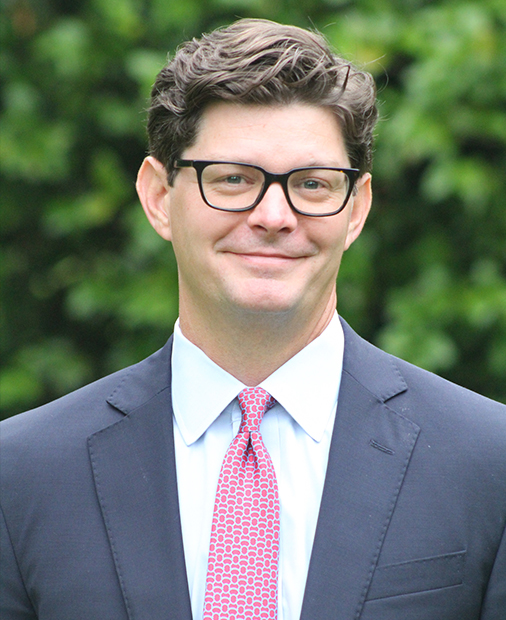Online Trademark Attorneys
Trademark Attorney Working With Clients in Quebec City, Quebec
If you're an entrepreneur, you know that protecting your intellectual property should be high on your list when it comes to safeguarding your company. However, as a successful business owner, you also know the steps and costs of filing a trademark in the U.S. can be expensive and arduous.
This conundrum can be even more overwhelming for new business owners who want to do everything possible to minimize the price of securing trademarks. They try to handle complicated tasks like trademark registration on their own, which can be a big mistake - especially when juggling the day-to-day tasks of running a business. You may be thinking, "But what about those set-it-and-forget-it services you can find online? All you have to do is plug in your info, and you're done." Using pre-made templates for trademark filing can be tempting, but doing so can leave you with inadequate protection and hurt you in the long run.
So, what is the easiest, most cost-effective route to consider that also minimizes legal risk? The truth is, before you spend money on an online filing service, it's best to consult with a trademark attorney working with clients in Quebec City, Quebec.
At Sausser Summers, PC, our experienced trademark attorneys can help you understand the trademark process step by step. We can even help with U.S. trademark filing, U.S. trademark responses, and U.S. trademark renewals at a price you can actually afford. That way, you can make an informed decision regarding your business without having to break the bank.
Resources
Sausser Summers, PC: Simplifying the U.S. Trademark Process
Hiring an attorney can be a daunting task, but at Sausser Summers, PC, our goal is to make the process as simple and seamless as possible for you. That's why we offer a straightforward checkout service. First, you choose your flat fee trademark service and fill out a short questionnaire. Then, we will contact you within 24 hours to discuss the details of our service. From there, one of our experienced trademark attorneys will get to work on your behalf.
Using a trademark attorney for filing in Quebec City, Quebec, can significantly increase your chances of a successful registration. The U.S. government recommends hiring a trademark attorney to help with your application, and our team of trademark lawyers is dedicated to meeting your needs. In fact, we help ensure your application is filed correctly the first time so you can get on with your life and avoid legal risks.
At Sausser Summers, PC, we work closely with our clients to understand their needs and provide them with sound professional advice. We never offer incomplete services, such as simply filing for registration, because that would leave you open to legal risks. You can rely on us to handle your intellectual property matters, and our flat fee services can help protect your business in a simple, straightforward, and affordable way. It's really that simple.
In terms of filing a U.S. trademark, we provide an easy three-step process to protect your intellectual property:
1. You provide your trademark info to our team via an online form.
2. Our team performs a comprehensive trademark search. This search ensures that no other marks will prevent you from registering your trademark in the U.S. Once performed, we'll send you a legal opinion letter that details our findings.
3. Sausser Summers, PC, files your U.S. trademark application. We are then listed as your Attorney of Record on file. From there, we'll provide ongoing updates regarding the status of your trademark as it works through the registration process.
The bottom line? At Sausser Summers, PC, we give both new and seasoned business owners an easy, efficient, cost-effective way to protect the one asset that sets them apart from others: their name.

The bottom line?
At Sausser Summers, PC, we give both new and seasoned business owners an easy, efficient, cost-effective way to protect the one asset that sets them apart from others: their name.
Do I Really Need a Trademark Attorney for Protecting My Business in Quebec City, Quebec?
It's not necessary to be a lawyer in order to apply for a trademark. Anyone can submit a trademark application to the U.S. Patent and Trademark Office (USPTO). However, registering a trademark involves more than just filling out a form. It's essential to conduct thorough research, accurately identify and clearly explain your trademark to ensure it receives adequate protection. And even after securing a trademark, you've got to monitor it consistently to make sure it's free from infringement.
The big takeaway here is that it's always a good idea to work with a trademark attorney to protect the intellectual property that you've worked so hard to establish. According to the Wall Street Journal, applicants are approximately 50% more likely to secure their trademark than people who file applications on their own. If your trademark application is rejected by the USPTO, you will need to revise and refile it, incurring additional filing fees. To avoid delays and extra costs, it is best to have a trademark lawyer help you get it right the first time.
Additional Benefits of Using a Trademark Attorney
Great trademark attorneys (like those you'll find at Sausser Summers, PC) will help with every step of filing and enforcing your trademark. Some additional benefits include the following:
Check to see if your proposed trademark is registered by another entity.
Conduct research to see if another business is using the trademark for which you're applying.
Provide advice and guidance on the strength of your trademark.
Draft and submit your trademark applications and application revisions.
Advice and guidance regarding trademark maintenance and protection.
Monitor the market for unauthorized use of your trademark.
Trademark enforcement to protect you against infringement.

Curious whether our trademark attorney services are right for you and your business? Contact Sausser Summer, PC, today. Let's talk about what you need, and how we can help.
What About Online Filing Services?
Online services, can provide you with basic assistance in filing your trademark. However, they will never be a legitimate substitute for an experienced trademark attorney helping clients in Quebec City, Quebec.

Although online filing services offer a step-by-step process, they take a one-size-fits-all approach to preparing legal documents. Even their advanced service only provides basic attorney assistance in completing your paperwork and helping with minor roadblocks. Online filing services' disclaimer highlights the many limitations of its services, including the fact that communications are not protected by attorney-client privilege. In addition, online filing services cannot provide advice, explanations, opinions, recommendations, or any kind of legal guidance on possible legal rights, remedies, defenses, options, selection of forms or strategies.
In other words, online filing services can offer you the necessary forms and point you in the right direction, but they cannot customize their services to your specific needs or help you with serious complications that may arise.
For the most comprehensive trademark service and protection, it's always wise to work with highly rated trademark lawyers, like you'll find at Sausser Summers, PC.
Understanding Trademarks Over Time
Trademarks in the U.S. can last indefinitely, but did you know that clients in Quebec City, Quebec can file a trademark online, only to lose protection in some circumstances? Trademarks differ from patents and copyrights in that they do not have an expiration date. However, to prevent the cancellation of a trademark, you must maintain it. To ensure that your trademark remains protected, you must actively use it in commerce and renew it with the USPTO every ten years.
The Lanham Act tells us that "use in commerce" is the legitimate use of a trademark in the ordinary course of trade. In other words, you cannot register a trademark solely to reserve the rights to it in the future. In most cases, a trademark must be used continuously in connection with the goods or services it is registered for.

Steps to Renew Your Trademark
Trademarks are registered with the USPTO and generally need to be renewed every ten years. However, there is one crucial exception that you should be aware of. Within the first ten years of owning a trademark, you must file for renewal between the fifth and sixth year from the date of your initial registration.
During this renewal period, you are required to submit a Section 8 declaration, a specimen that shows how the mark is being used, and pay the required fee. You can also apply for Section 15 Incontestability status, which can strengthen your trademark rights. This application, although not mandatory, can make it harder for others to challenge your ownership of the mark.
After the first renewal, which falls between the fifth and sixth year of ownership, the next renewal filing is due between the ninth and tenth year, and then every tenth year thereafter. In the ninth year you will need to file a Section 8 declaration, attesting to your use of the mark or excusable nonuse. You've also got to file a Section 9 renewal application before the end of the tenth year to keep your registration active.
It is worth noting that the USPTO provides a six-month grace period if you fail to renew your mark within the required time frame, but it is best not to rely on it. If you don't file within the grace period time limits, the USPTO will cancel and expire your mark.
By hiring trademark attorneys helping clients in Quebec City, Quebec, you can avoid the pitfalls and mistakes that can arise and cause you to lose your rights to the mark that represents it.
Losing Your Trademark Rights Through Abandonment
In the event that you stop using your trademark and have no plans to resume using it in commerce, it may be considered abandoned by the USPTO. This could result in the loss of your protective rights to the mark. Typically, a trademark is assumed to be abandoned if it has not been used for three years. However, you may be able to refute this presumption by providing evidence that you intend to use the mark again in the future.
Losing Your Trademark Rights Through Inappropriate Licensing
In addition to trademark abandonment, you should also be wary of improper licensing. It's important to remember that once you allow someone else to use your trademark, you must keep an eye on how they use it. You should monitor the products or services that feature your trademark to ensure that they meet consumers' expectations in terms of quality. Failure to do so can lead to a "naked" trademark license and the loss of your protective trademark rights.
How to Avoid Having to Refile Your Trademark
If you're wondering how you can avoid refiling your trademark, the answer is simple: file it correctly the first time around. Filing a trademark isn't inherently difficult, but when doing so, it's very important that certain aspects are filled out accurately in your application. If any information is missing or incorrect, the trademark application may be considered "void ab initio" or void from the beginning, requiring you to file again.
To avoid this, make sure that the information you provide in the application is accurate and complete, including the ownership of the trademark. For instance, if a corporation has multiple shareholders, it should not file under the President's personal name. The rightful owner should be the one/entity that ultimately controls the trademark and the associated goods/services.
It is also important to ensure that the goods and/or services description is precise. For example, if you sell electronic products, you should not file for research and development services despite having a research and development department. The goods/services description should reflect the goods/services you offer to customers, not the departments within your business.
Additionally, providing accurate dates of first use when filing for a trademark is crucial. The USPTO requires two dates to be specified - the date of first use anywhere and the date of first use in interstate commerce. Contact our trademark law office today to learn more about having accurate dates on your filing paperwork.


What Makes an Online Trademark Attorney Great?
At Sausser Summers, PC, we often get questions about how to distinguish run-of-the-mill consultants and others from great trademark attorneys. After all - when you're looking for an attorney to file or prosecute your business trademark, you should know their qualifications. Here are three ways you can separate the proverbial wheat from the chaff when it comes to trademark attorneys.
It's crucial to seek legal advice from a licensed trademark lawyer rather than relying on advice from non-professionals like trademark consultants. The USPTO even recommends hiring an attorney to help with the trademark process. Although trademark consultants may provide advice on trademark availability or name marketability, they cannot file the trademark for you or offer legal advice. According to the Rules of Practicing in trademark cases, "Individuals who are not attorneys are not recognized to practice before the Office in trademark matters." This rule applies to individuals who assist trademark applicants.
When searching for a trademark attorney, it's important to find someone with a strong background in trademark law. Look for an attorney who specializes in this area and has significant experience handling trademark-related cases. Avoid lawyers who don't have expertise in this field, as they may not be able to provide the guidance and support you need.
Ensure your attorney provides updates throughout the trademark registration process to avoid missing deadlines, including responding to any Office actions within six months. Failure to do so can result in trademark abandonment. The USPTO will only correspond with the listed attorney of record, so make sure your attorney keeps you informed.
In summary:
- Be sure you're using a licensed trademark attorney helping clients in Quebec City, Quebec.
- It's best to work with a trademark lawyer who has years of experience filing trademarks.
- Ensure that your trademark lawyer is willing to provide ongoing notifications relating to your trademark application process.

Trademark Attorneys Working Hard for You
Building your brand and gaining recognition for it is a significant achievement, and it's important to protect it. However, there are certain pitfalls and mistakes that can arise, causing you to lose your rights to the mark that represents it. By working with knowledgeable trademark attorneys, you can avoid these issues and file your trademark successfully.
With an A+ rating from the Better Business Bureau (BBB), Sausser Summers, PC, offers comprehensive guidance, strategic advice, and reliable representation for a variety of trademark matters. Our attorneys have years of real-world experience and, having registered countless trademarks with the USPTO, provide our clients with individualized representation when they need it most.
If you're looking for skilled, adept, and experienced counsel, look no further than our trademark law firm. Contact us today to schedule your initial consultation and learn how we can help you safeguard your brand.
Latest News in Quebec City, Quebec
Quebec, Ontario mayors excluded from White House meeting, diplomatic protocol cited
Morgan Lowriehttps://ca.news.yahoo.com/quebec-ontario-mayors-excluded-white-200905838.html
MONTREAL — Amid the trade war between Canada and the United States, Montreal Mayor Valérie Plante and St. Catharine's, Ont., Mayor Mat Siscoe have been denied accreditation for a meeting at the White House, according to the group who requested the meeting.The two mayors are in Washington, D.C., for a gathering of the Great Lakes and St. Lawrence Cities Initiative, a group of municipal and Indigenous government leaders who represent the region on both sides of the border.A spokesperson for the cities initiative says...
MONTREAL — Amid the trade war between Canada and the United States, Montreal Mayor Valérie Plante and St. Catharine's, Ont., Mayor Mat Siscoe have been denied accreditation for a meeting at the White House, according to the group who requested the meeting.
The two mayors are in Washington, D.C., for a gathering of the Great Lakes and St. Lawrence Cities Initiative, a group of municipal and Indigenous government leaders who represent the region on both sides of the border.
A spokesperson for the cities initiative says the names of Plante, Siscoe, and a mayor from an American city were submitted earlier this week ahead of Friday's meeting, scheduled as part of the annual Great Lakes Day event in Washington.
"After providing the three names, the cities initiative was informed on Wednesday, March 5, 2025, for the first time and just 48 hours before the planned meeting, that due to diplomatic protocol, there wasn’t enough time to process the requests of the Canadian mayors," the cities initiative said in a statement.
Instead, three American mayors will attend the meeting at the White House. Asked who from the White House will be present at the meeting, a spokesperson for the cities initiative said that was confidential.
U.S. and Canadian mayors from the cities initiative "have regularly been attending meetings at the White House during the annual Great Lakes Day event in Washington for many years with similar timelines and no obstacles," the group said. Meetings have traditionally focused on preserving and restoring the Great Lakes and St. Lawrence River Basin, it added.
Friday's meeting comes amid rising tensions between Canada and the United States following the imposition earlier this week of 25 per cent tariffs on Canadian products by U.S. President Donald Trump, and Canada's retaliatory tariffs. On Thursday, Trump signed an executive order that pauses tariffs on some Canadian imports linked to the auto industry that comply with the Canada-U.S.-Mexico Agreement, and also lowers levies on potash to 10 per cent.
In a statement earlier this week, Plante said she hoped to use her visit to Washington to speak with her cross-border counterparts about the adverse impacts of tariffs on the U.S. economy. "Citizens of both countries will suffer the consequences of this economic war and it is our duty, as a city, to do everything in our power to preserve as many ties as possible with our allies," she said Tuesday.
Quebec City Mayor Bruno Marchand, Laval Mayor Stéphane Boyer and Hamilton, Ont., Mayor Andrea Horwath were also among the nearly 30 elected officials from both sides of the border who were in Washington as part of the Great Lakes group.
In an email, Horwath described the exclusion of the Canadian mayors from Friday's meeting as "disappointing," adding, "my understanding is that this is a break from the way things have been done for many years prior."
This report by The Canadian Press was first published March 6, 2025.
Morgan Lowrie, The Canadian Press
More than 260 rental units to be built in Québec and Lévis Français
Canada Mortgage and Housing Corporation (CMHC)https://www.newswire.ca/news-releases/more-than-260-rental-units-to-be-built-in-quebec-and-levis-886165604.html
QUÉBEC, March 6, 2025 /CNW/ - The Government of Canada is investing more than $72 million to build 264 rental units in Québec and Lévis through the Apartment Construction Loan Program (ACLP).The announcement was made by the Honourable Jean-Yves Duclos, Minister of Public Services and Procurement, Quebec Lieutenant and Member of Parliament for Québec, in Québec at the site of the La Cour project in the neighbourhood of Saint-Roch.La Cour is a 159-unit project located on Prince-Édouard St...
QUÉBEC, March 6, 2025 /CNW/ - The Government of Canada is investing more than $72 million to build 264 rental units in Québec and Lévis through the Apartment Construction Loan Program (ACLP).
The announcement was made by the Honourable Jean-Yves Duclos, Minister of Public Services and Procurement, Quebec Lieutenant and Member of Parliament for Québec, in Québec at the site of the La Cour project in the neighbourhood of Saint-Roch.
La Cour is a 159-unit project located on Prince-Édouard Street in Québec. The Government of Canada is contributing $42 million to the project through low-interest loans. La Cour will include high-quality finishes and equipment so that families, individuals and couples can enjoy and benefit from highly accessible public transit, electric vehicle infrastructure and all local services. The property is strategically located in downtown Québec and will be completed by late 2025.
In addition, investments have been announced for two other large-scale residential projects, Le Natura and TERRA (Phase 3).
The Le Natura residential project will offer 33 new units and is located on Pie-XI Boulevard in Val-Bélair in a vibrant, multi-family area close to commercial amenities and public transit. The federal government has invested $8.5 million in the project, which is also located close to all municipal services and offers direct access to a main thoroughfare and a bicycle path. The project is presented as a green development with access to community gardens.
TERRA, located at 939-943 Monseigneur-Bourget Road in Lévis, is a 400-unit project, of which 72 units in this third phase have received $21.6 million in funding from the federal government through low-interest loans. The project's first two phases have already been completed. Driven by values of social and environmental responsibility the housing project has geothermal heating, an ecological storm water management system, gardening boxes and many green spaces. The building also features an innovative system that captures residual heat from wastewater, thereby reducing operating costs. The project's landscaping is made up entirely of gardens for edible produce, which encourages interactions between residents.
Quotes:
"Through investments in rental housing, our government is providing assistance to those who need it most, here in Québec and across the country. We are committed to revitalizing communities through initiatives like this one. These investments are helping to create jobs and stimulate the local economy." – The Honourable Nathaniel Erskine-Smith, Minister of Housing, Infrastructure and Communities
"Our government is committed to working with all partners to rise to address the housing crisis in Canada and Québec. Today's announcement confirms more than 260 new rental housing units for the population of Quebec City. By using all the tools at our disposal, we will overcome this crisis." – The Honourable Jean-Yves Duclos, Minister of Public Services and Procurement, Quebec Lieutenant and Member of Parliament for Québec
"Oïkos Construction's mission is to develop large-scale projects that will stand as examples of sustainable collective heritage, while also being a pioneer in terms of concepts, techniques and the training and management of our teams. Our La Cour apartment project is the very definition of collective wealth that offers a living environment that's adapted to a varied set of residents. We're very happy to work in collaboration with the Government of Canada to build a one-of-a-kind project in Québec's Lower Town." – Pierre-Yves Charest, President and CEO, Oïkos Construction Inc.
"TERRA rental condominiums and urban gardens offers a living space that fosters the well-being of our clients and improves their environment. What we do arises out of a desire to build supportive communities where people and sustainable development converge." – Martin Bégin, President and CEO, MGE Groupe Immobilier
Quick facts:
Additional information:
SOURCE Canada Mortgage and Housing Corporation (CMHC)
Contacts: Sofia Ouslis, Office of the Minister of Housing, Infrastructure and Communities, [email protected]; Media Relations, Canada Mortgage and Housing Corporation, [email protected]
Quebec announces $19B tramway project to connect eastern Montreal with off-island suburb
CBChttps://www.cbc.ca/player/play/video/9.6673373
The tram will connect Repentigny, Que., to Montréal-Est and Montréal-Nord. It will take years before it’s operational, but some critics already say it won’t appeal to car-dependent residents.Related StoriesMore Like ThisVideo2:13February 13...
The tram will connect Repentigny, Que., to Montréal-Est and Montréal-Nord. It will take years before it’s operational, but some critics already say it won’t appeal to car-dependent residents.
Related Stories
More Like This
Video 2:02
Recommended for You
Video 1:21
More from News
Trending Now
Quebec is saying ‘non’ to US goods — But one province is taking the boycott even further
Al Sciolahttps://www.mtlblog.com/tariffs-quebec-canada-poll
While Quebec and the rest of Canada don't always see eye to eye, it's safe to say that just about everybody is on edge about getting into a trade war with the United States.On Tuesday, U.S. President Donald Trump imposed a 25% tariff on Canadian and Mexican goods, prompting swift retaliatory measures from both nations. The economic standoff has sparked concerns across Canada, especially in Quebec.In an interview with Radio-Ca...
While Quebec and the rest of Canada don't always see eye to eye, it's safe to say that just about everybody is on edge about getting into a trade war with the United States.
On Tuesday, U.S. President Donald Trump imposed a 25% tariff on Canadian and Mexican goods, prompting swift retaliatory measures from both nations. The economic standoff has sparked concerns across Canada, especially in Quebec.
In an interview with Radio-Canada on Monday, Quebec Premier François Legault warned that these tariffs could jeopardize up to 160,000 jobs in the province over the next six months. With the stakes this high, folks in la belle province are already taking matters into their own hands by cutting back on U.S. products.
According to a recent Leger poll, Quebecers are boycotting American goods at a higher rate than most of the country.
Results from the web survey conclude that 69% of Quebecers have recently reduced their purchases of American products in stores, slightly above the national average of 67%. Only British Columbia reported a higher boycott rate, with 76% of respondents in that province saying they've cut back on American-made goods.
That sentiment goes beyond brick-and-mortar stores as 68% of Quebecers have reduced online purchases of American products, again exceeding the Canadian average of 63%. Folks in B.C. once again lead the charge, though, with 73% of participants reducing their online consumption of U.S. products.
Meanwhile, a whopping 66% of Quebec respondents say they've cut their spending on Amazon, significantly higher than the national average of 56% — likely due to the shopping giant recently pulling operations from Quebec, leading to thousands of people losing their jobs.
As they scale back on U.S. goods, many Quebecers are actively choosing to buy Canadian instead. The poll found that 72% have increased their purchases of locally made products, slightly above the national average of 70%. Among political groups, Bloc Québécois (BQ) supporters are the most committed to this shift, with a striking 85% saying they have prioritized local shopping.
This economic rift with the U.S. is also shaping Quebecers' perceptions of their southern neighbours. According to the survey, 32% of Quebecers now consider the U.S. an "enemy", compared to 30% of Canadians overall.
It's clear that Canadians — especially in Quebec and B.C. — are making a statement with their wallets. Americans, on the other hand, seem less concerned, with only 10% admitting to reducing their purchases of Canadian goods compared to 67% of Canadians cutting back on U.S. products.
Whether this boycott holds strong will likely depend on how the trade war unfolds.
Leger's latest survey was conducted online between Friday, February 28 and Sunday, March 2 among 1,548 Canadian adults.
Virtuoso announces Canadian winners at regional awards in Quebec City
Michael Pihachhttps://www.paxnews.com/news/agency/virtuoso-announces-canadian-winners-regional-awards-quebec-city
Michael Pihach is an award-winning journalist with a keen interest in digital storytelling. In addition to PAX, Michael has also written for CBC Life, Ryerson University Magazine, IN Magazine, and DailyXtra.ca. Michael joins PAX after years of working at popular Canadian television shows, such as Steven and Chris, The Goods and The Marilyn Denis Show.Virtuoso has announced the winners of its second-annual regional awards, which were held at its Forum Canada event at the Fairmont le Châte...
Michael Pihach is an award-winning journalist with a keen interest in digital storytelling. In addition to PAX, Michael has also written for CBC Life, Ryerson University Magazine, IN Magazine, and DailyXtra.ca. Michael joins PAX after years of working at popular Canadian television shows, such as Steven and Chris, The Goods and The Marilyn Denis Show.
Virtuoso has announced the winners of its second-annual regional awards, which were held at its Forum Canada event at the Fairmont le Château Frontenac in Quebec City Wednesday night (March 5).
The awards, which were presented at an elegant gala Wednesday night (March 5), honour members and partners that “consistently demonstrate their commitment to the Virtuoso network,” says the luxury travel consortium.
Direct Travel, notably, had a sweeping victory in Virtuoso’s top-producer category.
And the awards go to...
The regional Virtuoso Awards categories and winners were as follows:
Northern Lights Award. This recognition is for one member who goes above and beyond in engagement, activism, advocacy, sponsorship and the promotion of Virtuoso in Canada. They embody the commitment, humility and spirit of human connection within the Virtuoso network and are an example of what matters most to members, partners and travellers. This award went to Aaron Levine of Voyages Laurier du Vallon.
Most Engaged. This award recognizes a travel agency member and preferred partner with the highest engagement based on participation within the Virtuoso network.
Member: Ocean & River Cruises Travel
Partner. Windstar Cruises
Cruise Top Producer: Direct Travel
Hotels & Resorts Top Producer: Direct Travel
Tour Top Producer: Direct Travel
On-Site Top Producer: Direct Travel
Specialty Top Producer: Direct Travel
Cruise Top Producer: Celebrity Cruises
Hotels & Resorts Top Producer: Villas Of Distinction
Tour Top Producer: Collette
On-Site Top Producer: GILTEDGE - South Africa
Specialty Top Producer: Allianz Partners
Highest Cruise Annual Growth: Trevello Travel Group
Highest Tour Annual Growth: LuxeXperts - Transat
Highest On-Site Annual Growth: Civilized Adventures
Highest Specialty Annual Growth: Renshaw Travel
Highest Cruise Annual Growth: Royal Caribbean International
Highest Hotels & Resorts Annual Growth: Andaz Peninsula Papagayo Resort, Costa Rica
Highest Tour Annual Growth: Collette
Highest On-Site Annual Growth: IC Bellagio – Italy
Highest Specialty Annual Growth: Privé Jets
"Incredible contributions"
“Virtuoso’s global growth and evolution are driven by the incredible contributions of our members and partners, much of which happens at the regional level as we look to satisfy a diverse group of travellers and their unique preferences,” stated Virtuoso Chairman and CEO Matthew D. Upchurch, in a release. “Through our seven regional Forums worldwide, we are taking the opportunity to recognize members and partners who are elevating their professions and supporting those within this network, while also ensuring an unsurpassed client experience."
"We congratulate the recipients that were honoured with regional awards during our Canada Forum and thank them for their critical role in helping maintain the Virtuoso network’s collective leadership position within the industry.”
Virtuoso Forum Canada, happening March 4-6, offers agency owners and managers the opportunity to gather in a collaborative setting that promotes learning, sharing, and empowerment.
Forums share the latest on Virtuoso’s products and initiatives and also provide exclusive insights from Virtuoso’s senior leadership about plans for the upcoming year and beyond.
Additional regional awards will be announced at each Forum around the world: Greater China and North & Southeast Asia Forum in Shanghai (11-12 March), Continental Europe Forum in Lucerne (19-21 March), UK, Ireland, Middle East & Africa Forum in Malta (25-27 March) and Latin America & the Caribbean Forum in Buenos Aires (31 March-3 April).
Virtuoso’s Global Awards will continue to recognize top members and partners around the world and are announced at the annual Virtuoso Travel Week in Las Vegas from August 9-15.
Don't miss a single travel story: subscribe to PAX today! Click here to follow PAX on Facebook.
Disclaimer:

 Sausser Summers, PC
Sausser Summers, PC Call
us (843) 654-0078
Call
us (843) 654-0078